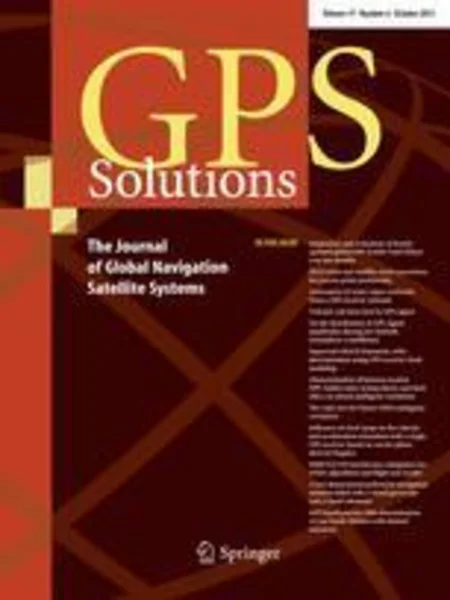-
orthogonality defect and reduced search-space size for solving integer least-squares problems
جزئیات بیشتر مقاله- تاریخ ارائه: 1392/07/24
- تاریخ انتشار در تی پی بین: 1392/07/24
- تعداد بازدید: 1029
- تعداد پرسش و پاسخ ها: 0
- شماره تماس دبیرخانه رویداد: -
in the context of ambiguity resolution (ar) of global navigation satellite systems (gnss), decorrelation among entries of an ambiguity vector, integer ambiguity search, and ambiguity validations are three standard procedures for solving integer least-squares problems. this paper contributes to ar issues from three aspects. firstly, the orthogonality defect is introduced as a new measure of the performance of ambiguity decorrelation methods and compared with the decorrelation number and with the condition number, which are currently used as the judging criterion to measure the correlation of ambiguity variance–covariance matrix. numerically, the orthogonality defect demonstrates slightly better performance as a measure of the correlation between decorrelation impact and computational efficiency than the condition number measure. secondly, the paper examines the relationship of the decorrelation number, the condition number, the orthogonality defect, and the size of the ambiguity search space with the ambiguity search candidates and search nodes. the size of the ambiguity search space can be properly estimated if the ambiguity matrix is decorrelated well, which is shown to be a significant parameter in the ambiguity search progress. thirdly, a new ambiguity resolution scheme is proposed to improve ambiguity search efficiency through the control of the size of the ambiguity search space. the new ar scheme combines the lambda search and validation procedures together, which results in a much smaller size of the search space and higher computational efficiency while retaining the same ar validation outcomes. in fact, the new scheme can deal with the case there are only one candidate, while the existing search methods require at least two candidates. if there are more than one candidate, the new scheme turns to the usual ratio-test procedure. experimental results indicate that this combined method can indeed improve ambiguity search efficiency for both the single constellation and dual constellations, respectively, showing the potential for processing high-dimension integer parameters in multi-gnss environment.
مقالات جدیدترین رویدادها
-
استفاده از تحلیل اهمیت-عملکرد در ارائه الگوی مدیریت خلاقیت سازمانی و ارائه راهکار جهت بهبود
-
بررسی تاثیر ارزش وجوه نقد مازاد بر ساختار سرمایه شرکت های پذیرفته شده در بورس اوراق بهادار تهران
-
بررسی تأثیر سطح افشای ریسک بر قرارداد بدهی شرکت های پذیرفته شده در بورس اوراق بهادار تهران
-
بررسی تأثیر رتبه بندی اعتباری مبتنی بر مدل امتیاز بازار نوظهور بر نقد شوندگی سهام با تأکید بر خصوصی سازی شرکت ها
-
تأثیر آمیخته بازاریابی پوشاک ایرانی بر تصویر ذهنی مشتری پوشاک ایرانی (هاکوپیان)
-
اثر تنش برشی استاتیکی اولیه بر مقاومت روانگرایی ماسه اشباع بابلسر در آزمایشات سه محوری تناوبی زهکشی نشده
-
منحنی های شکنندگی اسکله های شمع و عرشه
-
بررسی رابطه بین هوش مالی و ریسک پذیری کارکنان شهرداری اصفهان با رویکرد معادلات ساختاری
-
اثر سطوح مختلف پودر خشک شده میوه کیوی روی برخی از متابولیت های خونی جوجه های گوشتی
-
tow stage design for estimating the reliability of series/parallel systems
مقالات جدیدترین ژورنال ها
-
مدیریت و بررسی افسردگی دانش آموزان دختر مقطع متوسطه دوم در دروان کرونا در شهرستان دزفول
-
مدیریت و بررسی خرد سیاسی در اندیشه ی فردوسی در ادب ایران
-
واکاوی و مدیریت توصیفی قلمدان(جاکلیدی)ضریح در موزه آستان قدس رضوی
-
بررسی تاثیر خلاقیت، دانش و انگیزه کارکنان بر پیشنهادات نوآورانه کارکنان ( مورد مطالعه: هتل های 3 و 4 ستاره استان کرمان)
-
بررسی تاثیر کیفیت سیستم های اطلاعاتی بر تصمیم گیری موفق در شرکتهای تولیدی استان اصفهان (مورد مطالعه: مدیران شرکتهای تولیدی استان اصفهان)
-
بررسی میزان رضایت شغلی بین معلمان زن و مرد مقطع متوسطه اول شهرستان کهنوج در سال تحصیلی 1392-1391
-
بررسی و تحلیل مدیریت انتظامی پلیس در راستای مبارزه با قاچاق کالا
-
مسئولیت زنان در جامعه منتظر امام مهدی علیه السلام
-
analysis of the use of stem cells from the jurisprudence and islamic law
-
architecture and human rights




سوال خود را در مورد این مقاله مطرح نمایید :